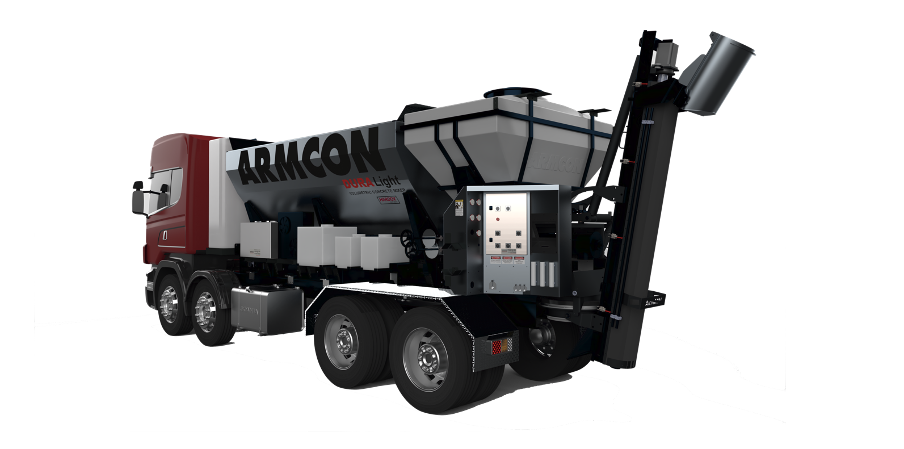The new legislation put in place in 2018 restricting the GVW (gross vehicle weight) at which volumetric concrete mixers could operate at, meant that Armcon took the decision to design a new machine. The existing mixer, AM4, at the new GVW of 32,000kg would have meant a payload of less than 7m³, which would be significantly less than what operators were used to carrying (which was up to 11m³ depending on chassis specification). We felt that 8m³ would still make volumetric mixers a viable alternative to drum mixers and based on analysis of typical batch sizes and number of jobs per day (using Armwatch data) it wouldn’t make a huge difference to our customer’s businesses day to day – some days there would be an extra trip back to the depot to load more materials, but other days it would be the same as it was with the old design machines. Another thing which contributed to our decision to design a new machine from scratch was to use it as an opportunity to bring our costs down through a leaner, smarter design which was faster to build, but also to break away from a lot of the imperial equipment such as motors, chains and sprockets, bearings and ancillary systems which meant we were still tied to US suppliers and the long lead times and higher shipping costs which are associated with that. So that set our design brief – 8m³ payload at 32,000kg, with lower costs and faster lead times so that we could pass these benefits onto our customers.
All of these benefits, however, could not be at the expense of quality or durability, which must be equivalent or greater to that of the machines which our customers are used to owning and operating. The way we chose to achieve this specification was to look at every aspect of the mixer individually and critically evaluate how we could remove unnecessary material and simplify the design to save weight, without sacrificing any strength. We also analysed all of the components used to see where we could replace imperial parts with metric versions which offered better value for money. Examples include the sub-frame and mixer frame, which replaced complex structural steel fabrications with Strenx high strength steel pressings which are 2.5 times stronger than the material used previously, allowing less material to be used without decreasing the strength of the structure. As Armcon were already using Hardox as an SSAB approved ‘Hardox In My Body’ member, this opened up the other products in their range to us and Armcon soon became an accredited ‘My Inner Strenx’ member too. The cement system also went through a significant transformation, simplifying the design by using a single metering and delivery auger – removing 2 augers and the cement clutch and gear arrangement but still being able to deliver from 150kg/m³ to 400kg/m³, saving yet more unnecessary weight. A move to a rotationally moulded polymer cement bin, shed further kilo’s and brought advantages such as improved material flow due to the very low friction material. We went through many iterations of the cement delivery design before settling on one which gave the most consistent delivery of materials throughout the full load. We also completely updated the hydraulic system, changing from heavy gear pumps which circulate oil all the time to a load sensing system, which only pumps the oil when it is needed. This allowed us to use a smaller tank with an oil cooler, reducing the oil capacity by over 50%. We also replaced the rotary actuator with a swivel cylinder and king pin arrangement, which brought the cost down significantly and is a much more robust and reliable design. The direct mount lift cylinder allowed the old lifting fabrications to be removed too, further reducing weight and cost.
Our modular design means we can assemble more quickly, and more intelligently – we can build sections of a machine separately and build multiple sections in parallel which previously wouldn’t have been possible. This approach allows the price of our mixers to remain competitive, but it also has advantages once the machine has been in service for many years – a replacement aggregate bin is now only a day’s work; unbolting the old one and securing a new one in its place, so keeping our mixers operational for longer is now much more cost effective.
Maintenance wasn’t forgotten either – we improved the chain lubrication system which previously became easily blocked and also routed this to the conveyor and cement drive chains as well as the chain & belt. We also added the option of an auto-greasing system to deliver the correct amount of grease to all bearings and pivot points. Other touches like making the bottom bearing changeable without removing the auger, and uprating the bearing to have a higher load rating than anything fitted to previous mixer designs reduces downtime as much as possible. Our wear blades now sit over the top of the flighting, so the steel no longer wears down – only the sacrificial part becomes worn (and it makes replacement easier too as the blades locate on top of the flighting to make positioning them easier). We also wanted to make our machine easier to use, so the extension chutes are now lighter and easier to handle (as well as safer). To add, the wash out hose is longer than before and easier to store without kinking – only small changes on their own, but they all add up to improve the user experience and reduce risk of breakdown.

